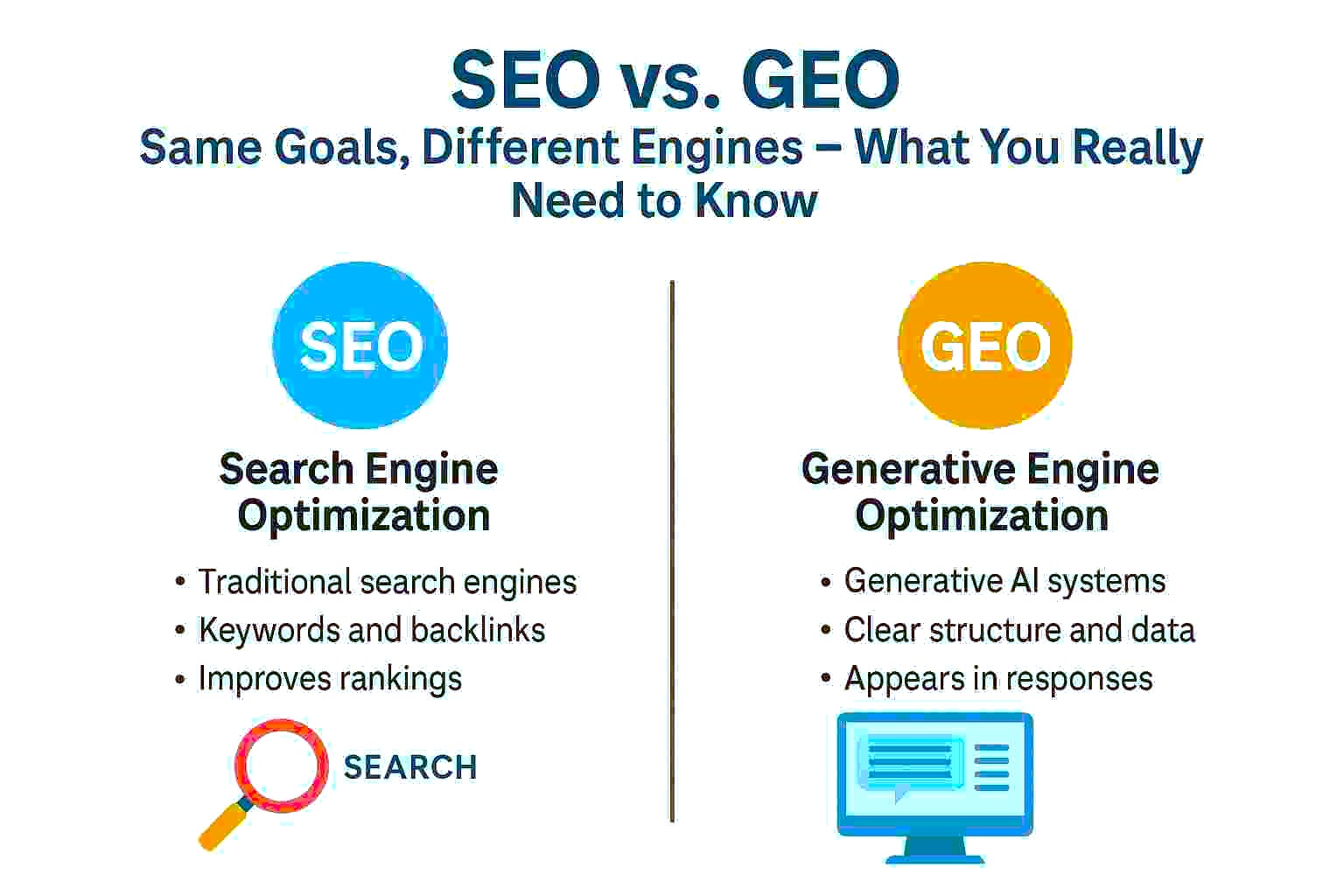Why Generative Engine Optimization (GEO) Matters for Tech Blogs 2025
What is Generative Engine Optimization (GEO) and why is it important?

Change is the only constant in today’s evolving digital marketing landscape. Keeping up with the latest innovations is no longer a choice, but a necessity for survival.
Generative engine optimization (GEO) is the latest major development that has transformed the way people search and interact with information online.
In this blog, we will explore the basics of GEO, providing you with the knowledge you need to manage these dynamic developments and stay ahead of your competitors.
What is GEO?
GEO stands for “Generic Engine Optimization,” which refers to the process of optimizing a site’s content to increase its visibility in AI-powered search engines like ChatGPT, Perplexity, Gemini, Copilot, and Claude AI.
This optimization helps your brand appear in AI-generated search results for users, particularly when they are searching for products, services, or information related to your area of expertise.
As user behavior changes in search, it’s increasingly important to have an effective presence in AI-generated results. It’s not just about visibility; it’s about connecting effectively and meaningfully with your customers and potential audiences, no matter where they start their search.
Ultimately, GEO helps you increase your site’s visibility, attract more targeted traffic, and convert visitors into loyal customers who return to your site repeatedly.

GEO vs. SEO
GEO and SEO are both cornerstones of modern digital marketing.
While SEO helps optimize content for traditional search engines like Google and Bing, GEO changes the way brands appear on AI-powered platforms.
Understanding the differences and similarities between GEO and SEO will allow you to optimize your content strategy for both traditional search and AI. Below, we’ll explore these similarities and differences and show you how you can leverage both to improve your online presence.
What are the similarities between GEO and SEO?
GEO and SEO share several basic goals and methods:
- Increased visibility: Both strive to make content more visible online and effectively reach the target audience.
- Keyword Strategy: Both use keywords strategically to make content more discoverable and relevant to user needs.
- User Experience: Both focus on creating content that is user-friendly, engaging, and easy to access.
- Content quality and relevance: High-quality, relevant content that meets user needs and is produced by the EEAT principles (Experience, Expertise, Authority, and Trustworthiness) is critical in both.
- Data and analytics insights: Using data and analytics to improve strategy, understand user behavior, and optimize content performance is important in both.
- Technical optimization: Paying attention to things like loading speed, mobile compatibility, and ensuring that search engines read and interpret content correctly are key features of both.
- Building Authority: Both help build brand authority and trustworthiness through authentic content and building effective relationships with the audience.
- Continuous adaptation: Both need to adapt to algorithm and technology changes to maintain optimal content visibility and performance.
What are the differences between GEO and SEO?
- Target search engines: SEO focuses on search engines like Google and Bing, while GEO is designed for AI-based platforms.
- Generating answers: In SEO, search engines provide a list of links, but in GEO, AI engines provide combined and comprehensive content as answers to users.
- Contextualizing content: In SEO, meta tags and site content are optimized with keywords, but in GEO, site content must be presented contextually and clearly so that artificial intelligence algorithms can produce more accurate answers.
- Information synthesis: In SEO, efforts are focused on improving the ranking of individual pages, but in GEO, the goal is to fully integrate content into comprehensive AI responses.
- Understanding user intent: SEO responds to user searches by matching keywords, while GEO uses artificial intelligence to more accurately understand user intent and provide more optimized responses.
- Algorithm adaptation: SEO requires constant adaptation to search engine algorithms, while GEO must keep pace with advances in artificial intelligence technologies and their processing methods.
- Content formatting: In SEO, content is optimized for search engines, but in GEO, content must be formatted in a way that is suitable for processing and understanding by artificial intelligence.
- Research-based strategy: SEO relies on keyword research and technical analysis, while GEO focuses on analyzing AI-generated content structures and content patterns.
- Performance Tracking: SEO examines the performance of organic search content, while GEO focuses on analyzing referral traffic from AI engines and how they display content.
Integrating GEO with SEO
While GEO is known as a standalone strategy in digital marketing, integrating it with SEO can multiply the effectiveness of online visibility. GEO and SEO share many common principles and techniques, and combining the two can result in a comprehensive and powerful strategy that maximizes online presence.
Effective strategies for combining GEO and SEO
- Integrated Content Strategy: Create content that is engaging and effective on both search engines and AI platforms. Your content should be high-quality, relevant, and aligned with principles like EEAT (Experience, Expertise, Credibility, and Trust).
- Comprehensive keyword research: Conduct research that not only covers the needs of search engines but also includes long-tail keywords, conversational searches, and contextual phrases needed by AI algorithms.
- Technical Excellence: Technical SEO is essential for both SEO and GEO. Ensure that your website is optimized for loading speed, mobile-friendly, uses structured data, and natural language processing.
- Continuous learning and adaptation: Keep up with changes in search engine algorithms and advances in artificial intelligence technology, and update your strategies based on these developments.
- Data-driven decision-making: Use data to improve and strengthen your optimization strategies with comprehensive SEO and GEO analytics.
By combining these two strategies, you can provide a unique user experience. SEO helps you rank your content better on traditional search engines, and SEO ensures that content is presented accurately and comprehensively on AI platforms. This integration results in users receiving relevant and engaging answers, engaging more with your content, and ultimately building loyalty and trust in your brand.
Why is generator engine optimization important?
With the rise of AI-powered search, the importance of GEO has also grown exponentially. While the initial excitement around AI has subsided, public trust in the technology is building, and the technologies are maturing. In this competitive landscape, Google is no longer the only leader, and innovative AI-powered platforms such as Bing, ChatGPT, and Perplexity are competing with search engines.
The impact of search engine optimization on organic search
Artificial intelligence is dramatically changing the organic search landscape, forcing businesses to rethink their marketing strategies. Forecasts suggest that by 2026, traditional search volume will decline by 25%, and organic search traffic will decline by more than 50%, as users increasingly shift to AI-powered searches. Furthermore, 79% of users are expected to use this type of search by next year, and 70% of them trust AI-powered results.
With these changes, relying solely on traditional SEO is not enough. Brands must effectively capture and retain user attention by integrating GEO into their strategies.
Changing user behavior in search
AI-powered search is changing the way people find and consume information. People are turning to AI platforms to find information, research products, and make purchases. For example, ChatGPT has over 180.5 million monthly active users, and Perplexity AI’s search volume has grown 858% in the past year, now reaching nearly 10 million monthly active users. These changes reflect the growing reliance on AI to deliver accurate, personalized information.
What are the benefits of optimizing a generator motor?
- Increased reach: By optimizing your content for AI, you have the chance to be seen on AI platforms in addition to search engines and can attract a wider audience.
- Improve user experience: Generative engine optimization helps optimize content so that AI can provide fast, relevant, and personalized responses, which increases user satisfaction and loyalty.
- Competitive Advantage: By adopting and adapting early to generative engine optimization, your brand can be recognized as a leader in this field and stand out from the competition.
- Brand Authority and Credibility: Optimizing content for AI platforms helps you position your brand as a trusted source. By combining information from different sources, AI platforms consider your content as one of the trusted sources.
- Data-driven insights: Search engine optimization provides you with valuable information that you can use to improve strategies, increase engagement, and improve user experience.
- Forward-thinking SEO strategy: Given the evolution of search technologies, integrating content optimization for AI platforms into digital marketing strategies ensures that your brand’s online presence and competitiveness are maintained.
The Benefits of Content Optimization for AI Platforms in Practice
To better understand the potential of GEO, let’s take a look at a study conducted by researchers at Princeton University, Georgia Tech, the Allen Institute for Artificial Intelligence, and the Indian Institute of Technology Delhi (IIT Delhi). This comprehensive study examined over 10,000 searches to identify key factors affecting GEO performance and practical ways to optimize content.
Download a PDF of Princeton University researchers’ article on artificial intelligence.
Evaluated tactics
In this study, several tactics were examined to increase content visibility:
- Keyword Boosting: Natural use of relevant keywords throughout the text.
- Citing credible sources: Linking to trusted sources to increase credibility.
- Adding statistics: Using quantitative data to support claims.
- Quotes from experts: Provide expert opinions to add depth to the content.
- Simplify language: Making complex concepts understandable to users.
- Correct spelling: Presenting the text without errors, without spelling mistakes, with proper punctuation and fluency.
- Use of specific vocabulary: Use unique words to enrich the content.
- Insert technical terms: Show expertise in specialized topics.
- Creating credible content: Using persuasive language to increase the credibility of the content.
Visual improvements
The results of this study showed that some tactics significantly improved content visibility:
Specifically, the tactics of using credible sources, adding citations, and using statistics showed a relative improvement of 30 to 40 percent. These methods, with minimal changes, can effectively increase the visibility of content in GEO, improving both its credibility and quality.”
Domain-based optimization
The study also found that the effectiveness of these tactics varied across different topics:
- Debate, History, and Science: Adding technical terms increased views.
- Business, Science, and Health: Psychological optimization made content clearer and more engaging.
- Statements, Facts, and Rights: Citing reliable sources was essential for greater accuracy.
- People and Society: Using authoritative quotes increased the visibility of the content.
- Law and Government: Relevant statistics added to the value and accuracy of the content.
Criticism and evaluation
Although the results of this study were promising, there are some criticisms of the methodology and results. There are concerns about potential biases, the use of simulated data, and the introduction of new content that may have influenced the findings. Critics such as Sandbox SEO have raised concerns about the overlap between GEO and traditional SEO, implicitly challenging the uniqueness of GEO.
How does GEO work?
GEO (Generative Engine Optimization) is a new strategy that aims to optimize content so that it is better accessible to generative AI systems (such as large language models) and your content is prioritized in response to requests.
Here we will broadly review the elements that make content optimization for AI platforms effective:
Research and analysis of generative artificial intelligence
This section includes an analysis of how AI systems work and their preferences for displaying content. To be successful in GEO, you need to understand how these systems analyze content and which formats and structures they prefer. Research in this section includes:
- Keyword and semantic research: Identify and target keywords related to searches driven by AI. Focus on long-tail keywords, organic searches, and phrases that are most commonly used in conversations. Semantic analysis can also help expand SEO research and identify related concepts to better understand user intent and increase content relevance.
- Analysis of AI summary answers: Review and identify keywords that lead to AI-generated summary answers. Analyze the structure of these answers, their topics, and the sources used to understand trends and popular formats such as paragraphs, lists, videos, and tables.
- Competitor Analysis: Identify businesses that appear in AI search results for your main keywords. Examine the strategies of these competitors to discover their strengths and weaknesses and identify growth opportunities.
- Brand Perception Research: Assessing how AI platforms like ChatGPT and GEMINI perceive your brand and using this information to positively impact and improve brand reputation.
- Content research: Analyzing the type of content and formats that are prioritized by AI search engines and aligning your content with these formats to be more visible in search results. It is essential to focus on structures that are relevant to AI algorithms.
- Response Analysis: Track changes in the structure of AI-generated responses, analyze topics, and citation methods used. Based on this information, adjust your strategy so that your content is always aligned with AI content processing and prioritization trends.
Content quality and relevance
Creating accurate and meaningful content that aligns with both user intent and AI systems’ priorities. At this stage:
- Conceptual Accuracy: Make sure your content precisely answers users’ questions and needs. Providing relevant and meaningful information that avoids unnecessary detail can improve the quality and relevance of search results.
- Semantic relevance: Using keywords and phrases that are relevant to the topic and user intent. Understanding the relationships between words and concepts helps align your content with semantic search intent and increase its relevance to user intent.
- Comprehensive Answers: Providing complete and accurate answers to users’ questions. AI-powered search engines tend to prioritize high-quality, comprehensive content that provides in-depth information.
- Informative and engaging: Your content should be both informative and engaging, and easy to understand. Producing comprehensive guides, in-depth articles, and interactive content that provide clear answers and actionable insights can have a positive impact on search results.
- Multimedia Integration: Diversify your content by adding visual and interactive elements like videos, infographics, and audio. This not only helps to engage users but also makes your content more relevant to AI-powered search engines.
- Focus on user intent: Always prioritize user intent when creating content. Understand the different types of searches and tailor your content to meet these needs. Aligning with user intent will make your content stand out from the AI’s perspective.
- Constantly update: Update your content regularly to show search engines that your content is fresh and up-to-date. This will improve your content’s ranking and visibility in line with current trends and user needs.
- Credibility and Trustworthiness: Strengthen your site as a trusted resource by citing trusted sources and demonstrating your expertise in various fields. Using expert quotes and relevant statistics will increase your site’s credibility and help improve rankings.
- Entity Optimization: Focus on key entities such as people, places, and concepts in your content. Use precise, descriptive terms and link to authoritative sources so that AI can better understand the relevance of these entities. This will help AI better identify and prioritize your content.
Content structure and clarity
For content to be properly processed by AI, it must be structured. Some tips:
- Content clarity: Make sure your content is clear and concise, highlighting key information at the beginning of the text. This will help AI understand the main message faster and improve user engagement. Use simple, direct language and avoid jargon that can be confusing.
- Introductory Sentence: Start each page with a clear and concise introductory sentence that introduces the main goal or topic. This sets the stage for both AI and users, increasing understanding and engagement.
- Content Readability: Use headings, bullet points, and multimedia elements to increase readability. This structure addresses both users’ need for organized and relevant information and AI’s need for understandable content.
- Structured Data: Use structured data like Schema Markup to help AI better understand your content. Mark up elements like articles, reviews, and products to improve how your content appears in search results and increase the likelihood of it appearing in featured features like knowledge panels and summarized snippets.
- Direct answers to questions: Provide direct, concise answers to frequently asked questions in the first few sentences of your content. AI tends to prioritize content that quickly answers users’ questions, and this increases the likelihood that your content will appear in AI-generated answers.
- Highlight key information: Use bullet points, numbered lists, and tables to emphasize important points. This makes your content more scannable and understandable for both AI and users.
- Optimize titles: Use clear, descriptive titles to organize your content. This helps AI algorithms better understand hierarchy and key points, improving the relevance and readability of your content.
Content distribution and engagement
GEO not only distributes your content in the best possible way, but also ensures that the content is effectively accessed. In the age of AI, distributing content doesn’t just mean publishing it; it means strategically placing it in places where AI systems can easily access, process, and prioritize it.
- Distribution across platforms: Large language models (LLMs) like those used by AI-powered search engines don’t just consider content on blogs, but also analyze content on communities like Reddit and Quora. So, distribute your content across these channels to influence the stories and answers generated by AI systems.
- User-Generated Content (UGC): Make your content authentic and diverse by encouraging users to provide reviews, recommendations, and social media posts. UGC can make your content more accessible and trustworthy, increase engagement, and show AI platforms that your content is active and relevant. Regular updates with UGC also align with user searches and increase the discoverability of your content, as AI systems prioritize fresh and relevant content.
- Use Social Media: Share your content on social media to increase its reach and engagement. AI uses social media signals to rank and index content. By maintaining an active social media presence, you ensure that your content is picked up and promoted by AI-powered platforms, improving your visibility and engagement.
- Build a community: By creating and nurturing a community around your brand through forums, social media groups, or dedicated platforms, you can increase user engagement. Engagement with your community can lead to user-generated content, feedback, and brand loyalty. Active communities provide a steady stream of fresh content and engagement that AI systems can analyze and prioritize, increasing the visibility of your content.
Brand reputation and credibility
GEO helps boost the visibility and credibility of your content by building and maintaining brand credibility, which is attractive to AI algorithms that value credible and trustworthy sources. Here’s how to do this effectively:
- Consistency: Make sure your brand messaging, data points, and key information are consistent across your website, social media profiles, and other online platforms. Consistent information helps build trust and credibility, and helps AI algorithms generate accurate answers and reinforce your credibility.
- Offline Reputation: Maintain a positive offline reputation, as this directly impacts your online presence. Just as Google’s algorithms consider offline brand reputation for online rankings, AI platforms also pay attention to your overall brand reputation. A strong offline reputation strengthens your credibility in the GEO space and ensures that your content is perceived as a trusted and authoritative source.
- Backlinking: To increase the credibility of your content, acquire quality links from relevant and authoritative sites. Engage in content marketing efforts like writing guest posts, creating shareable infographics, and publishing comprehensive research to attract organic links. Internal linking also helps AI better understand the relationships between content on your site.
- Ethical and transparent practices: Ensure all content is ethically produced and avoid deceptive practices that can lead to penalties. Be transparent about sources and affiliations to build trust and credibility for users and AI.
Technical SEO
GEO combines with traditional technical SEO practices to ensure that your site is technically sound and accessible, which is essential for discovery and prioritization by AI algorithms. Key components include:
- Optimize HTML tags: Use appropriate HTML tags such as title tags, meta descriptions, and header tags to improve content structure.
- Mobile optimization: Ensuring that the website is fully responsive and provides a seamless user experience across all devices.
- Improve loading speed: Implement best practices for faster loading times, such as compressing images, using browser caching, and optimizing code.
- Fix crawling and indexing issues: Regularly check for and fix issues that could prevent effective crawling and indexing of the site.
- Increase site security: Using HTTPS to ensure secure communication is favored by search engines and improves user trust.
Experiment and repeat
GEO is constantly evolving and requires flexibility and creativity from marketers. Here’s how to keep up with the changes and keep improving:
- Test different types of content: Create variety with a variety of formats, including articles, videos, infographics, and interactive elements. If you typically write blog posts, try producing a series of videos or infographics to see which types of content resonate best with your audience and AI platforms.
- Continuous testing: Use A/B testing to find best practices and continually make changes to improve visibility on AI-powered platforms. Experiment with different content formats and structures, and always make updates based on changes in AI algorithm preferences and response patterns. Also, AI values fresh content, so these tests can provide new opportunities to improve your visibility.
- Learn and adapt: Pay attention to audience interactions and refine your strategies based on these insights. Be prepared to quickly adapt to new trends and changes in AI algorithms and make data-driven decisions.
- Stay up-to-date: Stay informed about the latest trends and technologies in AI and GEO by following industry blogs, attending webinars, and joining forums. Engage with the community to gain new insights and learn about emerging practices and developments.
GEO is a continuous process
GEO is an ongoing process that requires constant exploration, tuning, and optimization. It’s not a one-time task; it’s a dynamic journey that aims to ensure your content remains fresh, relevant, and up-to-date in a fast-paced digital world.
To achieve your goals, regularly review your content performance. Remain flexible and adjust your strategies to keep pace with the constantly evolving AI search algorithms. Use data and user feedback to improve and adjust your content.
Future potential of generator engine optimization
The potential for future generative engine optimization is vast, as AI technologies continue to advance and more people integrate generative AI into various aspects of their lives. A recent survey from McKinsey found that 65% of organizations now regularly use generative AI, nearly double the number just ten months ago.
A look at the future of AI search
- Sophisticated AI capabilities: Imagine a future where AI not only answers questions but also anticipates users’ needs before they arise. As natural language processing advances, more accurate and sophisticated answers will be provided, improving the search experience.
- Voice and Visual Search: Integrating search engine optimization with voice and visual search technologies will transform user interactions. Voice search is becoming increasingly common, and visual search allows users to retrieve information by capturing images. Optimizing content for these formats will be essential.
- Seamless Integration: Combining generative engine optimization with technologies like augmented reality (AR) and voice search enhances interactions. Users can receive real-time visual guidance that makes information more engaging and accessible.
- Deep personalization: AI will deliver personalized experiences that tailor responses to individual preferences and behaviors. This level of personalization will redefine user engagement.
- The Evolution of Multimedia Search: The expansion to multimedia search allows AI to seamlessly integrate text, images, audio, and video, delivering richer and more comprehensive search results. Content creators must optimize across multiple formats to be visible in these enhanced search environments.
The journey of generative engine optimization is about more than keeping up with AI; it’s about pioneering the future of digital interactions. The future belongs to those who are ready to harness the full potential of generative AI and transform the way they have a digital presence.
Final word
Listen to your audience, because they know what they want.
Frequently Asked Questions
To have a piece of text appear in a generative search engine like ChatGPT that is connected to the Internet, does it have to be present in the first page results of search engines for the site’s content to be used?
Generative search engines that are capable of using the Internet typically gather their content from sources on web pages. Now, how likely a site’s content is to be seen and entered into the results of generative models depends on the following factors:
- Search Engine Results Page (SERP) Ranking:
- Content that appears on the first pages of search engines (especially the first page of Google) has a better chance of being accessed by users and even crawlers. This is important because users tend to trust links on the first page and are less likely to visit subsequent pages.
- Content quality:
- Content should be high-quality, accurate, and relevant. Search engines like Google use algorithms that prioritize relevant and useful content.
- Structured Data and Readability:
- Using structured data can help search engines better understand your site’s content. This data is especially important for display in new tools, such as search engines.
- Amount of backlinks and domain authority:
- Sites that have valid backlinks and higher domain authority usually rank higher and are more likely to be seen by search tools and crawlers.
- Fresh and updated content:
- New or updated content has a higher chance of being seen, as search engines prioritize fresh content.
- Site traffic and user engagement:
- Sites with high traffic and user engagement are likely to rank better in search engines, which helps with visibility.
- Training data:
- Language models like Gemini require a huge amount of data to learn and generate content. This data is usually collected from the web. Naturally, content that is on the first pages of search results is more likely to be seen and used by web crawlers.
Does skyscraper content have a higher chance of appearing in search engine results?
Yes, Skyscraper Content potentially has a better chance of appearing in the top search engine results, but with a few important caveats.
Why does skyscraper content have a better chance?
- Depth and Comprehensiveness: This type of content is usually comprehensive, going into depth on a topic. This is seen by search engines as an indication of the quality of the content.
- Natural Backlinks: Skyscraper content is often linked to naturally by other websites due to its high quality. These backlinks are considered a strong signal to search engines.
- User Value: Skyscraper content creates high value for the user due to its comprehensiveness and depth, and they are more likely to spend more time on your site. This factor is also important for search engines.
- Likelihood of Featured Snippets: If your content is structured appropriately (such as using lists, tables, or FAQs), it has a high chance of appearing in Featured Snippets. These positions capture the attention of both users and search engines.
Is optimizing content for search engines the same as optimizing for voice search?
Optimizing content for generative engines (like chatbots and AI models) has some similarities to optimizing for voice search, but there are also some significant differences between the two. Let’s compare the two:
Similarities
- Focus on natural language:
- In voice search, users typically use natural language and questions that resemble everyday conversation (e.g., “How do I bake a cake?”).
- Generating engines also collect information from content written in natural language and answer users’ questions.
- Using questions and answers:
- Both types of optimization require creating content that directly answers common questions users have, such as using a Frequently Asked Questions (FAQ) section.
- Importance of Featured Snippets:
- Voice search is usually dependent on the content available in Featured Snippets.
- Information generation engines also often use prominent, structured sections of content to extract data.
- Focus on Long-Tail Keywords:
- In both cases, long-tail, question-based keywords (like “Where are the best traditional restaurants in Tehran?”) are very important.
Differences
- How to use the content:
- Voice search: The goal is to provide users with quick and concise answers. The algorithm only renders a small portion of the content (like a paragraph).
- Generating engines: These engines may read the entire content, synthesize it, or even rewrite parts of it. Therefore, the content should be more comprehensive and accurate.
- Main audience:
- Voice search: Focus is on end users. Content should be short and functional.
- Generative engines: The focus is more on making content easily understood and processed by AI models.
- Need for more complex structuring:
- For search engines, it is more important to use Structured Data or Schema.org markup so that the algorithms can extract data better.
- In voice search, this need is less, as search engines focus on simpler answers.
- Information type:
- Voice search: Users are typically looking for quick answers and actionable information.
- Generative engines: These models require detailed and in-depth information to provide reliable and comprehensive content.
- Content length and depth:
- For voice search, the content should be short and direct (answers in a few sentences or a paragraph).
- For generative engines, content needs to be both accurate and include deeper details.






